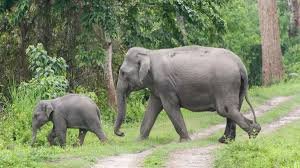Widespread anger erupted in Assam after the remains of three wild elephants were found in the Panbari Range of Manas National Park, situated near the Indo-Bhutan border in Bijni, Chirang district. Forest officials suspect poachers targeted the animals for their tusks, sparking a wave of protests across the state.
Student organisations, including the All Assam Students’ Union (AASU), All Bodo Students Union (ABSU), and Chirang District Students’ Union, held emergency press conferences and rallies on Saturday, condemning the forest department’s negligence. They demanded immediate arrests of the culprits and accountability from higher officials. Activists accused the forest administration of consistent failure in protecting endangered wildlife, citing repeated incidents in recent years within protected areas.
AASU leaders said the killing of the elephants was not an isolated event but part of a larger pattern of rising wildlife crimes in the region. They claimed the administration lacked the will and efficiency to prevent such crimes. They further alleged a nexus between poachers and some corrupt forest officials, calling for an independent investigation into the incident. Student unions warned that if authorities fail to act within a week, they would launch a mass agitation across Assam to demand justice for the slain elephants.
Locals residing near the park expressed shock and sorrow over the killings. They said elephant herds frequently travel between the park and Bhutan’s forests, and the murders have disturbed the harmony between humans and wildlife in the area. Some community leaders in Bijni offered support to the student organisations, stating that wildlife conservation should be a shared priority.
Manas National Park, a UNESCO World Heritage site and part of the Project Elephant and Project Tiger initiatives, has faced increasing threats due to poaching and habitat loss. Environmentalists pointed out that the latest killings raise serious questions about surveillance, staffing, and patrolling capabilities in core areas of the park. They criticised the forest department for relying on outdated methods in a time when technology could be used for better wildlife protection.
Forest department officials confirmed the incident and launched a preliminary inquiry. Senior officers visited the site and conducted field inspections. They collected evidence and have sent the carcasses for forensic examination. While they promised strong action, student leaders and conservationists remained sceptical, citing poor follow-up in earlier cases.
Tripartite coordination between forest departments of India, Bhutan, and local conservation groups has been slow, even though elephants frequently migrate through these regions. Wildlife experts called for a renewed trans-border wildlife monitoring programme and real-time communication between enforcement teams across boundaries. They said greater cooperation could help in early detection and prevention of poaching attempts.
As public anger escalates, social media campaigns using hashtags like #JusticeForElephants and #SaveManas have gone viral. Citizens and influencers have joined the call for justice, urging stronger wildlife protection laws and better monitoring of national parks. Petitions have begun circulating online, demanding the resignation of senior officials if they fail to resolve the case swiftly.
Assam Forest Minister Chandra Mohan Patowary stated the government would leave no stone unturned to apprehend those responsible. He said the state would deploy additional surveillance resources, including drones and night-vision equipment, to strengthen patrolling across Manas and other critical habitats. He also promised a review of the current park management system.
As the investigation continues, student unions plan to hold candlelight vigils and submit memorandums to the Chief Minister, urging him to take personal interest in the case. The state awaits further developments, but the message from youth and citizens alike is clear—Assam’s forests and its elephants must be protected at all costs.




